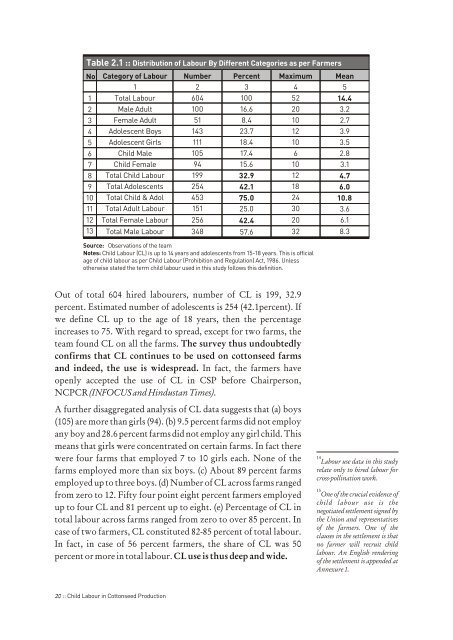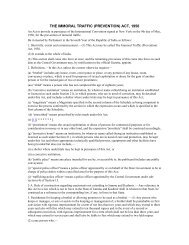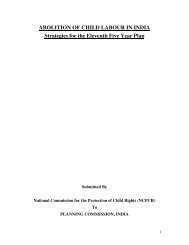Child Labour in Cottonseed Production by Ashok Khandelwal
Child Labour in Cottonseed Production by Ashok Khandelwal
Child Labour in Cottonseed Production by Ashok Khandelwal
Create successful ePaper yourself
Turn your PDF publications into a flip-book with our unique Google optimized e-Paper software.
Table 2.1 :: Distribution of <strong>Labour</strong> By Different Categories as per Farmers<br />
No<br />
1<br />
2<br />
3<br />
4<br />
5<br />
6<br />
7<br />
8<br />
9<br />
10<br />
11<br />
12<br />
13<br />
Category of <strong>Labour</strong><br />
1<br />
Total <strong>Labour</strong><br />
Male Adult<br />
Female Adult<br />
Adolescent Boys<br />
Adolescent Girls<br />
<strong>Child</strong> Male<br />
<strong>Child</strong> Female<br />
Total <strong>Child</strong> <strong>Labour</strong><br />
Total Adolescents<br />
Total <strong>Child</strong> & Adol<br />
Total Adult <strong>Labour</strong><br />
Total Female <strong>Labour</strong><br />
Total Male <strong>Labour</strong><br />
Number<br />
2<br />
Out of total 604 hired labourers, number of CL is 199, 32.9<br />
percent. Estimated number of adolescents is 254 (42.1percent). If<br />
we def<strong>in</strong>e CL up to the age of 18 years, then the percentage<br />
<strong>in</strong>creases to 75. With regard to spread, except for two farms, the<br />
team found CL on all the farms. The survey thus undoubtedly<br />
confirms that CL cont<strong>in</strong>ues to be used on cottonseed farms<br />
and <strong>in</strong>deed, the use is widespread. In fact, the farmers have<br />
openly accepted the use of CL <strong>in</strong> CSP before Chairperson,<br />
NCPCR (INFOCUS and H<strong>in</strong>dustan Times).<br />
A further disaggregated analysis of CL data suggests that (a) boys<br />
(105) are more than girls (94). (b) 9.5 percent farms did not employ<br />
any boy and 28.6 percent farms did not employ any girl child. This<br />
means that girls were concentrated on certa<strong>in</strong> farms. In fact there<br />
were four farms that employed 7 to 10 girls each. None of the<br />
farms employed more than six boys. (c) About 89 percent farms<br />
employed up to three boys. (d) Number of CL across farms ranged<br />
from zero to 12. Fifty four po<strong>in</strong>t eight percent farmers employed<br />
up to four CL and 81 percent up to eight. (e) Percentage of CL <strong>in</strong><br />
total labour across farms ranged from zero to over 85 percent. In<br />
case of two farmers, CL constituted 82-85 percent of total labour.<br />
In fact, <strong>in</strong> case of 56 percent farmers, the share of CL was 50<br />
percent or more <strong>in</strong> total labour. CL use is thus deep and wide.<br />
604<br />
100<br />
51<br />
143<br />
111<br />
105<br />
94<br />
199<br />
254<br />
453<br />
151<br />
256<br />
348<br />
Percent<br />
3<br />
100<br />
16.6<br />
8.4<br />
23.7<br />
18.4<br />
17.4<br />
15.6<br />
32.9<br />
42.1<br />
75.0<br />
25.0<br />
42.4<br />
57.6<br />
Maximum<br />
4<br />
Source: Observations of the team<br />
Notes: <strong>Child</strong> <strong>Labour</strong> (CL) is up to 14 years and adolescents from 15-18 years. This is official<br />
age of child labour as per <strong>Child</strong> <strong>Labour</strong> (Prohibition and Regulation) Act, 1986. Unless<br />
otherwise stated the term child labour used <strong>in</strong> this study follows this def<strong>in</strong>ition.<br />
20 :: <strong>Child</strong> <strong>Labour</strong> <strong>in</strong> <strong>Cottonseed</strong> <strong>Production</strong><br />
52<br />
20<br />
10<br />
12<br />
10<br />
6<br />
10<br />
12<br />
18<br />
24<br />
30<br />
20<br />
32<br />
Mean<br />
5<br />
14.4<br />
3.2<br />
2.7<br />
3.9<br />
3.5<br />
2.8<br />
3.1<br />
4.7<br />
6.0<br />
10.8<br />
3.6<br />
6.1<br />
8.3<br />
14 <strong>Labour</strong> use data <strong>in</strong> this study<br />
relate only to hired labour for<br />
cross-poll<strong>in</strong>ation work.<br />
15 One of the crucial evidence of<br />
child labour use is the<br />
negotiated settlement signed <strong>by</strong><br />
the Union and representatives<br />
of the farmers. One of the<br />
clauses <strong>in</strong> the settlement is that<br />
no farmer will recruit child<br />
labour. An English render<strong>in</strong>g<br />
of the settlement is appended at<br />
Annexure 1.





